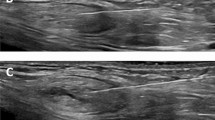Abstract
This report demonstrates the feasibility and safety of using contrast-enhanced ultrasound (CEUS) to confirm intranodal needle position in children requiring dynamic contrast-enhanced magnetic resonance lymphangiography (DCMRL). A total of 7 patients were evaluated using CEUS after nodal puncture on a detachable magenetic resonance table, with 2 nodes cannulated in each patient, resulting in a combined evaluation of 14 nodes. The nodal cannulation success rate using CEUS was 85.7% (12/14 nodes). DCMRL was performed successfully in all patients with good contrast opacification of the central conducting lymphatics. Out of the 14 nodes, 2 nodes in the same patient demonstrated persistent extravasation on CEUS despite needle readjustment, requiring conversion to fluoroscopic lymphangiography. No adverse event related to the injection technique or CEUS was reported.
Graphical abstract










Similar content being viewed by others
Data Availability
The datasets generated during and/or analysed during the current study are available from the corresponding author on reasonable request.
References
Ramirez-Suarez KI, Tierradentro-Garcia LO, Smith CL et al (2022) Dynamic contrast-enhanced magnetic resonance lymphangiography. Pediatr Radiol 52:285–294
Savla JJ, Itkin M, Rossano JW, Dori Y (2017) Post-operative chylothorax in patients with congenital heart disease. J Am Coll Cardiol 69:2410–2422
Nadolski GJ, Ponce-Dorrego MD, Darge K et al (2018) Validation of the position of injection needles with contrast-enhanced ultrasound for dynamic contract-enhanced MR lymphangiography. JVIR 29:1028–1030
Mejia EJ, Otero HJ, Smith CL et al (2020) Use of contrast-enhanced Ultrasound to determine thoracic duct patency. JVIR 31:1670–1674
ACR Committee on MR Safety (2020) ACR manual on MR safety, version 1.0. American College of Radiology. https://www.acr.org/-/media/ACR/Files/Radiology-Safety/MR-Safety/Manual-on-MR-Safety.pdf
Wagenpfeil J, Kupczyk PA, Henkel A et al (2022) Ultrasound-guided needle positioning for nodal dynamic contrast-enhanced MR lymphangiography. Sci Rep 12:3621
Squires JH, McCarville MB (2021) Contrast-enhanced ultrasound in children: implementation and key diagnostic applications. AJR Am J Roentgenol 217:1217–1231
Author information
Authors and Affiliations
Contributions
All authors contributed to the study conception and design. All authors were involved in the primary care of the patients. Material preparation and data collection were performed by K.F.K.F. The first draft of the manuscript was written by K.F.K.F. and all authors commented on subsequent versions of the manuscript. All authors read and approved the final manuscript.
Corresponding author
Ethics declarations
Ethical approval
All procedures performed in this report were in accordance with the ethical standards of the institutional review board and with the 1964 Helsinki declaration and its later amendments or comparable ethical standards. Institutional review board approval for this retrospective study was obtained.
Conflicts of interest
None
Additional information
Publisher's note
Springer Nature remains neutral with regard to jurisdictional claims in published maps and institutional affiliations.
Supplementary information
Below is the link to the electronic supplementary material.
Supplementary file1 (MOV 4784 kb)
Supplementary file2 (MOV 89379 kb)
Supplementary file3 (MOV 82355 kb)
Rights and permissions
Springer Nature or its licensor (e.g. a society or other partner) holds exclusive rights to this article under a publishing agreement with the author(s) or other rightsholder(s); author self-archiving of the accepted manuscript version of this article is solely governed by the terms of such publishing agreement and applicable law.
About this article
Cite this article
Fung, K.F.K., Chen, Hs.R., Ng, W.K.C. et al. Feasibility of contrast-enhanced ultrasound in confirming intranodal needle position for dynamic contrast-enhanced magnetic resonance lymphangiography in children. Pediatr Radiol 53, 2137–2143 (2023). https://doi.org/10.1007/s00247-023-05718-2
Received:
Revised:
Accepted:
Published:
Issue Date:
DOI: https://doi.org/10.1007/s00247-023-05718-2




